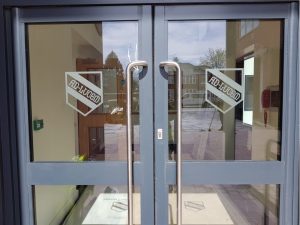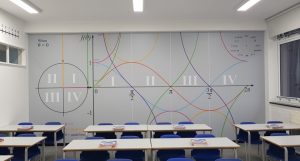As many of us working in the education sector know, managing energy use across school buildings is a constant challenge. With tight budgets and rising utility costs, finding practical solutions that reduce overheads without compromising comfort or learning conditions is crucial. One area that’s often overlooked is the impact of windows – particularly how much heat and light they allow in. Left unchecked, large expanses of glazing can lead to uncomfortable indoor temperatures and spiralling energy bills. That’s where solar control window film comes into play.

We’ve seen firsthand how effective this solution can be in schools. By applying high-performance window film to existing glazing, we can dramatically reduce the amount of solar heat gain in the summer and limit heat loss in the winter. The result? Cooler classrooms during hot spells, less reliance on air conditioning or electric fans, and more stable internal temperatures throughout the year. For older buildings that were never designed with thermal performance in mind, this small change can make a surprisingly big difference.
Reducing Cooling Costs in Warmer Months
One of the biggest benefits of solar control window film is its ability to block a significant percentage of the sun’s heat. In school buildings, especially those with large south-facing windows or older single-glazed units, heat build-up can become overwhelming during warmer months. This not only makes classrooms uncomfortable for pupils and staff but can force schools to run expensive air conditioning systems or rely on portable cooling units. Over time, these costs mount up.
Solar control film acts like a barrier, rejecting up to 80% of the sun’s solar energy before it passes through the glass. This dramatically reduces the internal temperature without the need for mechanical cooling. In our experience, schools that install this film see a measurable drop in electricity usage during summer term, with staff also reporting improved comfort and fewer heat-related complaints from pupils.

Improving Energy Efficiency Year-Round
It’s not just summer when window film proves its worth. Many of the solar control films available today have insulating properties that help retain warmth in the colder months. That means less heat escapes through the glass in winter, reducing the need for excessive heating. For schools with older buildings, particularly those that can’t afford full window replacement programmes, this is a highly cost-effective way to improve thermal performance.
By applying film to key areas, such as high-use classrooms, libraries, and admin blocks, we can help regulate temperature throughout the year. It’s an approach we’ve used extensively in schools across the UK, and the long-term savings on gas and electricity bills often exceed the initial installation cost within just a few years.

Creating a More Comfortable Learning Environment
Energy savings are only part of the picture. Solar control window film also helps improve comfort levels by reducing glare, which can be a real problem in classrooms using screens and projectors. Pupils and staff are less likely to be distracted by harsh light, which can help support better concentration and productivity.
In addition, reducing excessive heat means fewer complaints, less disruption, and fewer health concerns related to overheating – which, as Public Health England has pointed out in its guidance, can affect children more acutely than adults. A stable, moderate internal climate is essential for effective learning, and this solution supports that goal with minimal disruption to the school day.

Supporting Safeguarding and Compliance Goals
Schools also have a responsibility to provide safe and suitable working environments for both staff and pupils. Installing solar control window film can contribute towards meeting environmental and health and safety compliance, particularly in older school buildings that may struggle with modern insulation standards. As part of our service, we offer tailored advice on film specification to meet both energy and safeguarding requirements.
Our solar control window film options include a range of finishes, from subtle tints to mirrored designs that also enhance daytime privacy – an added benefit for safeguarding in areas overlooked by public spaces.
Proven Results in Educational Settings
We’ve worked with numerous schools across the country to improve glazing performance and reduce energy costs. On our Our Work in Schools page, you’ll find examples of projects where we’ve delivered practical solutions with measurable results. In many cases, facilities managers report lower running costs and improved feedback from teaching staff after installation.
Whether it’s a new-build academy with large expanses of glass or a Victorian-era primary school with single-pane windows, we tailor our approach to meet the needs of each individual site. Our experience working in education means we understand the constraints of working during term time, and our team is trained to operate with minimal disruption and full DBS clearance.
A Cost-Effective Alternative to Window Replacement
Full window replacement in schools is often too expensive or logistically complex to consider, especially where planning restrictions apply. Solar control window film provides a simple, affordable alternative that can be installed quickly and without major building works. The return on investment can be seen within a few years, with continued savings for many more to follow.
This is particularly relevant in the context of government targets for public sector decarbonisation. Measures like window film installation support more sustainable energy use and contribute to carbon reduction goals, aligning with funding initiatives such as the Public Sector Decarbonisation Scheme administered by Salix Finance.
Tailored Solutions for Every School
Every school is different, and we never take a one-size-fits-all approach. We assess factors such as building orientation, existing glazing, internal use, and energy usage patterns before recommending a solution. Whether your priority is cutting cooling costs, improving privacy, or enhancing safety, we’ll help you select the right film for your school’s unique needs.
We also work closely with facilities teams and leadership staff to plan installations at convenient times, including holidays and half-terms, to ensure minimal impact on teaching time.
If your school is looking for practical, cost-effective ways to reduce energy usage and improve comfort, solar control window film offers a proven solution. With over two decades of experience in the industry and a strong track record of successful education projects, we’re confident this is an investment that pays off in more ways than one.
Get in touch today!
FAQs
How does solar control window film help reduce energy costs in schools?
Solar control window film works by reducing the amount of solar heat that enters through windows. In summer months, this keeps classrooms cooler, meaning less need for fans or air conditioning. In winter, certain films also help retain heat indoors. By reducing the load on heating and cooling systems, schools can lower their energy bills across the year. We’ve seen schools report noticeably lower electricity usage in warmer terms after installation.
Is solar control window film suitable for older school buildings?
Yes, it’s particularly effective in older buildings that lack modern glazing or insulation. For schools where window replacement isn’t an option due to cost or listed status, film offers a quick and cost-effective alternative. It can be applied directly to existing glass with minimal disruption, and there’s no need for major building work. It’s one of the most accessible ways to improve thermal comfort in heritage or budget-restricted settings.
Will solar control film affect natural light or visibility?
No, not significantly. The films we install are designed to reduce glare and heat while still allowing in plenty of natural daylight. We offer a range of finishes — from clear to lightly tinted, and reflective — so schools can choose the level of visibility and light transmission that suits each space. For classrooms, offices and shared spaces, we typically recommend a balance between heat rejection and visible light transmission.
Can solar control film improve classroom comfort for pupils and staff?
Absolutely. By reducing hot spots and glare, classrooms stay more comfortable, especially during warmer weather. That makes a real difference to concentration levels and overall wellbeing. In our experience, staff often report fewer complaints and disruptions after film is installed, and IT-based lessons are easier to manage without screen reflections or uncomfortable heat levels.
How long does the installation take, and will it disrupt teaching?
We plan all installations around the school’s timetable to avoid disruption. Most projects are completed during holidays or half-term breaks. For smaller areas, we can often work outside teaching hours. Our installers are fully DBS-checked and experienced in working in educational environments, so everything is managed professionally and safely. The film is applied internally, with minimal mess or downtime.
